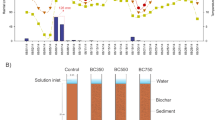Abstract
Concentrations of a wide range of trace elements: arsenic, cadmium, cobalt, chromium, hafnium, nickel, thorium, uranium, zinc and the rare earth elements, cerium, europium, samarium, terbium and ytterbium were determined by instrumental neutron activation analysis in the brown alga,Fucus vesiculosus from Eckwarder Hörne, North Sea and from Rügen, Baltic Sea. Another brown alga,Sargassum filipendula from Sri Lanka, Indian ocean (representing an unpolluted control station) was similarly investigated. Cobalt, chromium and nickel concentrations were highest inF. vesiculosus from the North Sea while zinc was highest in samples from the Baltic Sea, reflecting high levels of these elements in coastal waters of the North and the Baltic sea. Cadmium, cobalt, nickel and zinc levels were lowest inS. filipendula from Sri Lanka, probably demonstrating lower levels of those elements in coastal waters. Concentration levels of hafnium, thorium, uranium, and the rare earth elements were highest inS. filipendula. Two years later in 1994,S. filipendula along withUlva sp. (green alga) was resampled from the same sampling site, and in addition to the above elements, six other trace elements (Ag, Ba, Br, Rb, Se and Sr) were determined.Sargassium filipendula showed a particular affinity for Ag, As, Br and Sr. For the other elements, marginal concentration differences were observed betweenS. filipendula andUlva sp., probably reflecting the regional background levels. Substantially higher concentrations of Hf, Th, U, and the rare earths were found again in the 1994Sargassum andUlva samples, reflecting the effect of a substrate rich in rare earth elements. The brown algae used in this study may be used to monitor trace elements in coastal waters.
Similar content being viewed by others
References
Adriano, D.C. 1986.Trace Elements in the Terrestrial Environment. Springer Verlag, New York, Heidelberg.
Fuge, R. and James, K.H. 1973. Trace metal concentrations in brown seaweeds, Cardigan Bay, Wales.Marine Chemistry,1, 281–293.
Gschneidner Jr, K.A. and Eyring, L. (eds). 1990.Handbook on the Physics and Chemistry of Rare Earths, Volume 13. North-Holland, Amsterdam, New York.
Jayasekera, R. 1994. Pattern of distribution of selected trace elements in the marine brown alga,Sargassum filipendula Ag. from Sri Lanka.Environmental Geochemistry and Health,16, 70–75.
Levine, H.G. 1984. The use of seaweeds for monitoring coastal waters. In: L.E. Shubert (ed.),Algae as Ecological Indicators, pp 188–210. Academic Press, London, New York.
Markham, J.W., Kremer, B.P. and Sperling, K.R. 1980. Effects of cadmium onLaminaria saccharina in culture.Marine Ecology Progress Series,3, 31–39.
Moris, A.W. and Bale, A.J. 1975. The accumulation of cadmium, copper, manganese and zinc byFucus vesiculosus in the Bristol Channel.Estuarine and Coastal Marine Science,3, 153–163.
Nickless, G., Stenner, R. and Terrille, N. 1972. Distribution of cadmium, lead and zinc in the Bristol Channel.Marine Pollution Bulletin,3, 188–190.
NIES, 1988.No. 9 Sargasso. Certificate of analysis, National Institute of Environmental Studies, Japan.
Rossbach, M., Zeisler, R. and Woittiez, J.R.W. 1990. The use of Compton suppression spectrometers for trace element studies in biological materials. In: R. Zeisler and V.P. Guinn (eds),Nuclear Analytical Methods in the Life Sciences, pp. 63–73. The Humana Press, Clifton, NJ.
Seeliger, U. and Edwards, P. 1977. Correlation coefficients and concentration factors of copper and lead in seawater and benthic algae.Marine Pollution Bulletin,8, 16–19.
Shubert, L.L. (ed.) 1984.Algae as Ecological Indicators. Academic Press, London, New York.
Stoeppler, M., Burow, M., Backhaus, F., Schramm, W. and Nürnberg, H.W. 1986. Arsenic in seawater and brown algae of the Baltic and North Sea.Marine Chemistry,18, 321–334.
Weichart, G. 1973. Pollution of the North Sea.Ambio, 2, 99–106.
Author information
Authors and Affiliations
Rights and permissions
About this article
Cite this article
Jayasekera, R., Rossbach, M. Use of seaweeds for monitoring trace elements in coastal waters. Environ Geochem Health 18, 63–68 (1996). https://doi.org/10.1007/BF01771133
Received:
Accepted:
Issue Date:
DOI: https://doi.org/10.1007/BF01771133




